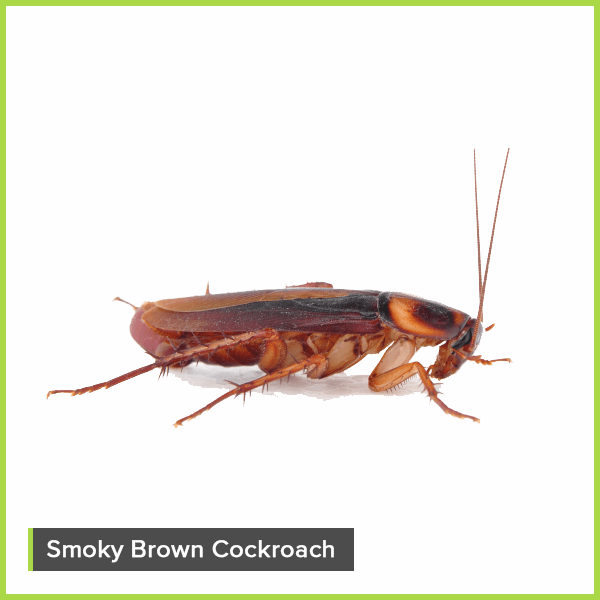How to Identify the Different Types of Cockroaches
It may be more important then you think to be able to identify types of cockroaches. Whilst some are similar there are also striking differences between the species be it there appearance, habitat, life cycle or food. In media most cockroaches shown are American cockroach (periplaneta americana) or brown banded cockroach (supella longipalpa), yet there are so many more types of cockroaches out there.
The Most Common Types Of Australian Cockroaches:
Below you will find a list of the most common cockroaches in Australia, I will outline some of their most noticeable characteristics.
This list will include the Australian cockroach, the oriental cockroach the German cockroach and the smoky brown cockroach.
Australian Cockroach (periplaneta australasiae)
- Appearance: The Australian cockroach is a reddish brown colour with a yellow line around its head, it can sometimes me misidentified as an American cockroach. However, the Australian cockroach is much smaller with a body length around 23-35 mm long.
- Habitat: This cockroach is nocturnal and will usually spend its day hiding in dark corners, under doors, and in cracks and crevices. It prefers damp and moist climates like the perimeter of your home or in areas where there is access to water
- Life Cycle: This species of cockroaches, the Australian cockroach grow from egg to adult in about a year. The average lifespan of an adult cockroach is 4 to 6 months. Females lay egg cases, which contain about 24 eggs each, in sheltered areas and in material such as moist wood.When it’s time for the eggs to hatch, the female will hide the tiny egg case out of reach.Nymphs (baby cockroaches) molt several times as they grow, eventually developing their wings and before that, blotchy yellow spots along their backs. In 6 to 12 months, nymphs reach the adult stage and begin producing their own eggs.
The adult lifespan of the Australian cockroach is 4-6 months.
- Food: You’ll find Australian roaches in areas indoors on the hunt for something to eat close to food and water: sinks, bathtubs, cabinets, drains and water pipes. Unfortunately, being so close to a food supply, your kitchen is a prime location to colonize. Apartment buildings, shopping centers, malls, and other large structures are also at risk of invasion by Australian cockroaches.
Oriental Cockroach (blatta orientalis)

- Appearance: The oriental cockroach is dark brown to black in colour and is around 20-25 mm in length. Females tend to grow up to 5 mm larger than males but have no wings, while the males are smaller and have large wings that cover much of their body. This cockroach is much smaller then the American cockroach which is the largest species in the world.
- Habitat: These cockroaches are commonly found in damp, dark, and covered areas. They can often be found in and around your pipes and drains because of the abundant source of water.
- Life Cycle: Adults: Live on average for 6 months. Can be distinguished from nymphal stages by the presence of wings in the males and wing stubs in the females.
- Food: Oriental cockroaches will eat almost anything, including decaying organic matter and trash.
German Cockroach

- Appearance: German cockroaches light brown in colour and have distinct dark brown lines running along the edge of their body. They are noticeably smaller than the other six types of cockroaches on this list, only growing between 13-16 mm in length. These cockroaches are much faster and smaller than the other 6 types, making them harder to detect.
- Habitat: The german cockroach like dark and humid spaces like kitchen and bathroom drains, crevices, and air ducts. They are food scavengers so it’s also common to find them in places where food is stored like cupboards.
- Life Cycle: German cockroach are one of the most common cockroach species found in households. German cockroach undergo three distinct life phases: egg, nymph and adult. Their entire life cycle spans approximately 100 days
- Food: German cockroaches are omnivorous scavengers. They are attracted particularly to meats, starches, sugars, and fatty foods. Where a shortage of foodstuff exists, they may eat household items such as soap, glue, and toothpaste.
Smoky Brown Cockroach

- Appearance: Smoky brown cockroaches much like their name are smoky brown in colour! We’d describe it as a rich mahogany. They’re quite big, growing between 35-40 mm in length with wings that extend well beyond their bodies on average.
- Habitat: Sadly these critters don’t just simply crawl inside properties through cracks and crevices. Unfortunately these roaches can also fly! They’re rather nocturnal in nature and are usually found outside in sheltered and warm, humid climates, such as sheds, etc. They will make their way inside in search of food though.
- Life Cycle: The egg capsule (oothecae) of the smokey brown cockroach is large and brown. The female usually glues the oothecae to objects in the harbourage.The oothecae holds an average of 17 eggs, but there have been cases of them holding 24 – 26, but this is not common.The Nymphs take between 6 – 12 months to develop, those that are nymphs in the summer will over-winter.
The adults live for 6-12 months during which time the female will produce about 17 oothecae.
- Food: It is also not uncommon to see these insects taking a drink when water is available. While smoky brown cockroaches prefer to eat decaying plant matter, the opportunistic feeders will consume any food source available to them, such as: Dead insects. Fecal matter.
How To Get Rid Of Cockroaches
There are a lot of methods that people can use to get rid of cockroaches. The problem is that cockroaches are notoriously hard to kill and just two of them can create a lot more. Generally speaking, if you see a couple of cockroaches, there are probably a lot more and they are very good at hiding.
Prevention is better than cure in all pest control issues and here are a few hints and tips for preventing cockroaches, as well as dealing with an early ‘infestation’; Sticky traps, that trap the cockroaches onto the paper can work if you spot them within a few hours of being in your property (don’t forget to discard them into a bin outside of the property!)
Even if you find no more than one or two cockroaches, you simply must clean the area with strong detergents etc. and keep the area clean.
Check for leaks too and if you find one, get it dealt with as cockroaches need water to survive. Keep an eye on the area, as you may see young cockroaches for another two or three weeks after this initial onset Seeing them for longer? Think you have more? Don’t hesitate.
Call in a professional pest controller who can identify the species of cockroach, tell you how and where they are gaining access to your property, provide effective, yet safe, treatment in and around your home and provide preventative advice. If the infestation is coming from a neighbouring property, they could help in advocating, on your behalf, to get that property treated too.

WE'RE NOT HAPPY UNLESS YOU'RE HAPPY
SEE HOW IT WORKSWith Competitive Pest Control Services you’ll never have to worry about paying for a job that hasn’t been done.
If you’re not satisfied with our services, we’ll not only give you your money back, we’ll return it to you twofold. That’s right: you’ll not only receive a full refund, we’ll also pay to have your pest problem sorted by our competition.*
We’re always trying to raise the standard of service, it’s one of the reasons we were name Australian Pest Manager of the Year four times in the past six years. When you employ our services, you know your pest problem will soon be a distant memory. What could be more satisfying than that?
*Please contact us to hear more about our 200% Money Back Guarantee - as due to issues sometimes outside our control, not all services may be covered by this offer.





 Instagram
Instagram  LinkedIn
LinkedIn